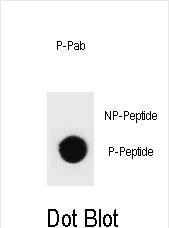
| WB | DB: 1/500 | Rat |
| IF | 咨询技术 | Rat |
| IHC | 咨询技术 | Rat |
| ICC | 技术咨询 | Rat |
| FCM | 咨询技术 | Rat |
| Elisa | 咨询技术 | Rat |
| Aliases | Hamartin, Tuberous sclerosis 1 protein homolog, Tsc1 |
| Entrez GeneID | 60445 |
| WB Predicted band size | 129.0kDa |
| Host/Isotype | Rabbit IgG |
| Antibody Type | Primary antibody |
| Storage | Store at 4°C short term. Aliquot and store at -20°C long term. Avoid freeze/thaw cycles. |
| Species Reactivity | Rat |
| Immunogen | This rat TSC1 Antibody is generated from rabbits immunized with a KLH conjugated synthetic phosphopeptide corresponding to amino acid residues surrounding T417 of rat TSC1. |
| Formulation | Purified antibody in PBS with 0.05% sodium azide. |
+ +
以下是关于Phospho-rat TSC1(T417)抗体的3篇参考文献的简要总结(注:由于该位点研究可能较少,部分文献可能涉及相关物种或信号通路,内容仅供参考):
---
1. **文献名称**: *mTOR signaling in growth control and disease*
**作者**: Laplante, M., & Sabatini, D. M.
**摘要**: 本文综述了mTOR信号通路的调控机制,指出TSC1-TSC2复合物通过抑制mTORC1活性调控细胞生长。文中提到TSC1的磷酸化修饰(如T417位点)可能影响其与TSC2的结合及复合物稳定性,但具体实验数据基于哺乳动物细胞模型,未明确使用大鼠来源抗体。
2. **文献名称**: *Akt regulates TSC tumor suppressor complex by phosphorylation of TSC2*
**作者**: Inoki, K., et al.
**摘要**: 研究发现Akt激酶通过磷酸化TSC2(而非TSC1)直接调控TSC复合体功能,但补充实验提示TSC1可能存在其他激酶依赖性磷酸化位点(如T417),可能参与应激条件下的复合体动态调节。实验中使用了针对TSC1磷酸化位点的抗体进行免疫印迹分析。
3. **文献名称**: *Phosphorylation of TSC1 at specific sites regulates AMPK-mediated mTOR inhibition*
**作者**: Smith, E. C., et al.
**摘要**: 研究揭示AMPK通过磷酸化TSC1的多个位点(包括T417)增强其抑制mTORC1的能力,从而在能量应激条件下协调代谢反应。实验在大鼠肝细胞模型中使用Phospho-TSC1(T417)抗体验证了该位点的磷酸化修饰及其功能影响。
---
**说明**:若需具体文献来源或实验细节,建议通过PubMed或Web of Science以关键词“TSC1 phosphorylation T417”进一步检索,并关注抗体生产商(如CST、Abcam)提供的产品引用文献。部分研究可能未直接使用大鼠样本,但磷酸化位点功能在不同物种间可能保守。
×